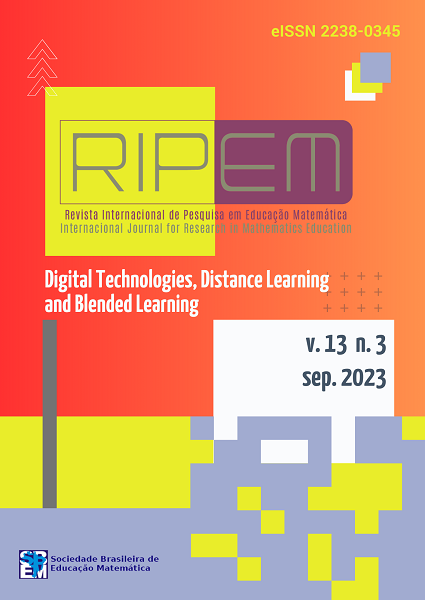Triangle similarity: interactions in meshes and slider
DOI:
https://doi.org/10.37001/ripem.v13i3.3543Palavras-chave:
Similarity, Congruence, Triangles, Proportionality, VMTwGResumo
This article discusses the interactions of (prospective) teachers when performing two tasks in a multiuser, online, virtual, and synchronous version of GeoGebra, the VMTcG. When analyzing the data, the discursive aspects, the modalities of dragging points and the categories of signs present in the process of semiotic mediation are considered. The first episode involves the use of the square grid in a task on congruence of triangles, and the second one, a task on the similarity ratio from a slider. The data make it possible to conclude that the thought processes related to the use of the checkered grid were limited to the exploration of more global properties and relations of ascending aspect, while those related to the use of the slider may represent a more potent form of thought process, which implies both the global observation of properties and the validation of conjectures.
Downloads
Referências
Alqahtani, M. M. & Powell, A. B. (2016). Instrumental appropriation of a collaborative, dynamic-geometry environment and geometrical understanding. International Journal of Education in Mathematics, Science and Technology, 4(2), 72-83.
Alqahtani, M. M. & Powell, A. B. (2017a). Mediational activities in a dynamic geometry environment and teachers’ specialized content knowledge. Journal of Mathematical Behavior, 48, 77-94.
Alqahtani, M. M. & Powell, A. B. (2017b). Teachers’ instrumental genesis and their geometrical understanding in a dynamic geometry environment. Digital Experiences in Mathematics Education, 3, 9-38.
Arzarello, F., Olivero, F., Paola, D. & Robutti, O. (2002). A cognitive analysis of dragging practises in Cabri environments. ZDM, 34(3), 66-72.
Bairral, M. A. & Barreira, J. C. F. (2017). Algumas particularidades de ambientes de geometria dinâmica na educação geométrica. Revista do Instituto GeoGebra de São Paulo, 6(2), 46-64.
BRITO, C. S. (2022). Licenciandos e professores de matemática interagindo no VMTcG em atividades de semelhança de triângulos. 2022. 152f. Dissertação (Mestrado em Educação em Ciências e Matemática). Universidade Federal Rural do Rio de Janeiro. Seropédica, RJ.
Bussi, M. G. B. & Mariotti, M. A. (2008). Semiotic mediation in the mathematics classroom: Artifacts and signs after a Vygotskian perspective. In: L. D. English (Org.). Handbook of international research in mathematics education. (2a. ed., pp.746-783). Abigdon, Oxon: Routledge.
Costa, M. S. & Allevato, N. S. G. (2011). O conceito de proporcionalidade através da resolução de problemas de geometria: perspectivas didáticas de (futuros) professores de Matemática em formação inicial. In: Anais do 2º Seminário em Resolução de Problemas (pp.1-13). Rio Claro, SP.
Galvão, M. E. E. L., Souza, V. H. G. & Miashiro, P. M. (2016). A transição das razões para as funções trigonométricas. Bolema, 30(56), 1127-1144.
Gattegno, C. (1987). The science of education: Part 1: Theoretical considerations (2a. ed). New York, NY: Educational Solutions.
González, R. L., Nieto, L. B., GarcÃa, M. N., Pesquero, C. S., Zurita, L. M., & GarcÃa, L. M. C. (1990). Proporcionalidad geométrica y semejanza. In: Grupo Beta. Madri: Sintesis.
Jaconiano, E. A., Barbosa, A. C., Costa, M. V. T, & Concordido, C. F. R. (2019). Resolução de problemas de proporcionalidade por meio da redução à unidade. Educação Matemática em Revista, 24(61), 98-113.
Lima, E. L. Medida e forma em geometria: comprimento, área, volume e semelhança. (4a. ed.). Rio de Janeiro, RJ: SBM, 2011.
Machado, N. J. (2000). Semelhança não é mera coincidência. São Paulo, SP: Scipione.
Maciel, A. C. & Almouloud, S. A. (2004). Semelhança de figuras planas: uma proposta de ensino In: Anais do 8º Encontro Nacional de Ensino de Matemática (pp.1-12). Recife, PE.
Maingueneau, D. (2000). Termos-chave da análise do discurso. Tradução de M. V. Barbosa & M. E. A. T. Lima. Belo Horizonte, MG: Editora UFMG.
Mariotti, M. A. (2000). Introduction to Proof: the Mediation of a Dynamic Software Environment. Educational Studies in Mathematics, 44, 25-53.
Menduni-Bortoloti, R. D. & Barbosa, J. C. (2018). Matemática para o ensino do conceito de proporcionalidade a partir de um estudo do conceito. Educação Matemática Pesquisa: Revista do Programa de Estudos Pós-Graduados em Educação Matemática, 20(1), 269-293.
Oliveira, R. & Bairral, M. (2020). Interações em um ambiente de aprendizagem online e sÃncrono: que tarefa propor com o GeoGebra? Paradigma, 61(2), 277-304.
Pereira, M. F. F. Uma sequência didática para ensino de semelhança de figuras. (2017). 166f. Dissertação (Mestrado Profissional em Ensino de Matemática). Universidade do Estado do Pará. Belém, PA.
Powell, A. B. (2014). Construção colaborativa do conhecimento tecnológico, pedagógico e do conteúdo de professores de matemática. Boletim Gepem, 64, 1-19.
Powell, A. B. & Alqahtani, M. M. (2021). Estudantes usando geometria dinâmica e construindo critérios necessários para semelhança e congruência de triângulos. In: M. A. Bairral & M. P. Henrique. (Org.). Smartphones com toques da educação matemática: mãos que pensam, inovam, ensinam, aprendem e pesquisam. (1a. ed., pp. 33-42). Curitiba, PR: CRV.
Stahl, G., Koschmann, T. & Suthers, D. (2008). Aprendizagem colaborativa com suporte computacional: Uma perspectiva histórica. Boletim Gepem, 53, 11-42.
Tinoco, L. A. A. (1996). Razões e proporções. Rio de Janeiro, RJ: Editora UFRJ.
Publicado
Como Citar
Edição
Seção

Este trabalho está licensiado sob uma licença Creative Commons Attribution-NonCommercial-ShareAlike 4.0 International License.








